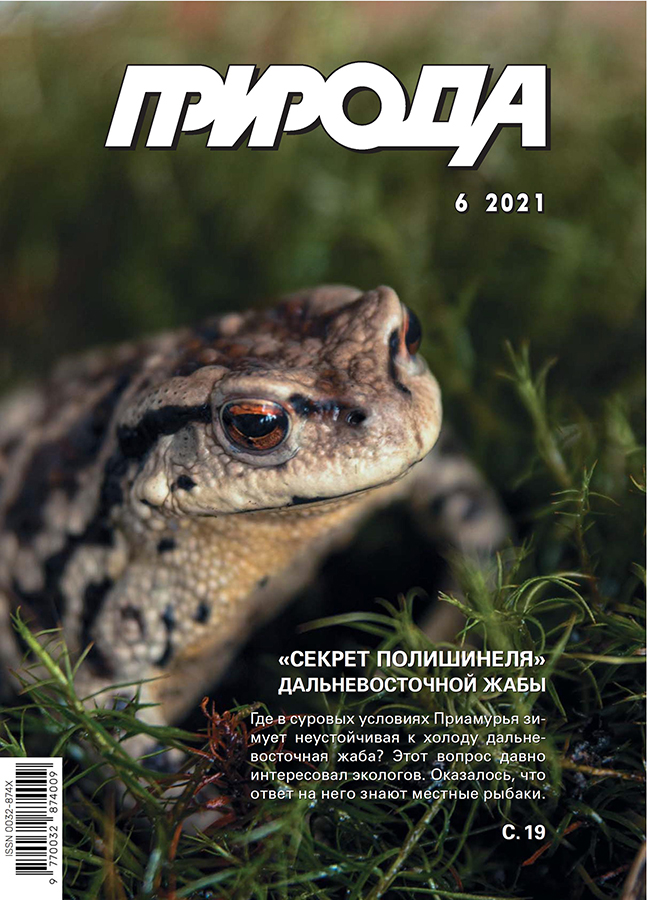Дальневосточная жаба: «секрет Полишинеля» по-амурски
- Авторы: Берман Д.И1, Тагирова В.Т2, Кришкевич Д.Д3
-
Учреждения:
- Институт биологических проблем Севера ДВО РАН
- Тихоокеанский государственный университет
- Средняя общеобразовательная школа с.Иннокентьевка
- Выпуск: № 6 (2021)
- Страницы: 19-30
- Раздел: Статьи
- URL: https://journals.eco-vector.com/0032-874X/article/view/627999
- DOI: https://doi.org/10.7868/S0032874X2106003X
- ID: 627999
Цитировать
Полный текст
Аннотация
Жизнь амфибий в Северной Евразии невозможна без специальных адаптаций к экстремальным температурам на суше или к гипоксии в воде. Эта сторона экологии пока мало исследована, даже места зимовки многих амфибий известны лишь приблизительно. Типичная ситуация в Приамурье — с дальневосточной жабой. Находки зимующих на суше и в воде животных поздней осенью редки; выживают ли они до весны, непонятно. Как и другие виды жаб Северной Евразии, она не переносит охлаждения ниже –3°C. Подобные температуры в грунтах равнинных территорий от Комсомольска-на-Амуре до Благовещенска отмечаются на глубине более 1.5 м. Случайно выяснилось, что место массовой зимовки жаб представляет собой «секрет Полишинеля»: в сети рыбаков подо льдом на Амуре (между Хабаровском и Комсомольском-на-Амуре) вместе с рыбой регулярно попадают жабы. Наблюдения показали, что весной из воды дружно выходят перед ледоходом или сразу после него взрослые и молодые, самки и самцы. Осенью же жабы идут на зимовку не одновременно, а потому незаметно. Вероятно, на севере в российской части ареала основное место их зимовки — равнинные участки рек, тогда как на юге (в Центральном и Юго-Западном Китае) преимущественно верхние горизонты почвы.
Ключевые слова
Об авторах
Д. И Берман
Институт биологических проблем Севера ДВО РАН
Email: aborigen@ibpn.ru
Магадан, Россия
В. Т Тагирова
Тихоокеанский государственный университет
Email: valtix@mail.ru
Хабаровск, Россия
Д. Д Кришкевич
Средняя общеобразовательная школа с.Иннокентьевка
Email: kramid@mail.ru
Хабаровский край, Россия
Список литературы
- Yu T.L., Gou Y.Sh. Overwintering habitat selection of Asiatic toad, Bufo gargarizans in southwestern China. Biharean Biologist. 2010; 4(1): 15–18.
- Su J., Han M., Zhu X. et al. Habitat selection of the Asiatic toad (Bufo gargarizans) during hibernation in the Badagongshan National Nature Reserve, central China. Salamandra. 2020; 56(1): 16–26.
- Тагирова В.Т. Жизнь Приамурских земноводных и пресмыкающихся. Хабаровск, 2009.
- BulakhovaN.A., Meshcheryakova E.N., BermanD.I. Cryoresistance of three toad species from North Asia. Proceedings of the 19th SEH European Congress of Herpetology. Salzburg, 2017.
- Флякс Н.Л. Биология бесхвостых амфибий Южного Сахалина в условиях антропогенного воздействия на естественные биоценозы. Канд. дисс. М., 1991.
- Pinder A.W., Storey K.B., Ultsch G.R. Estivation and hibernation. Environmental Physiology of the Amphibians. Feder M.E., Burggren W.W. (eds.). Chicago, 1992.
- Kolobaev N.N., Tarasov I.G. Amphibians of the Amurskaya Province. Advances in Amphibian Res. in the F. Soviet Union. 2002; 5: 169–191.
- Кузьмин С.Л., Маслова И.В. Земноводные российского Дальнего Востока. М., 2005.
- Laitinen M., Pasanen S. Wintering site selection by the common frog (Rana temporaria) and common toad (Bufo bufo) in Finland: A behavioural experiment. Ann. Zool. Fennica. 1998; 35(1): 59–62.
- Elmberg J. Ecology and natural history of the moor frog (Rana arvalis) in boreal Sweden. The Moor Frog. Zeitschrift für Feldherpetologie, Supplement. 2008; 13: 179–194.
- Шестеркин В.П. Зимний гидрохимический режим Амура. Вестник ДВО РАН. 2007; 4: 35–43.
- Шестеркин В.П. Сезонная и пространственная изменчивость химического состава вод верхнего Амура. Региональные проблемы. 2016; 19 (2): 35–42.
Дополнительные файлы









